Engage NY Eureka Math 1st Grade Module 2 Lesson 14 Answer Key
Eureka Math Grade 1 Module 2 Lesson 14 Sprint Answer Key
A
*Write the missing number.
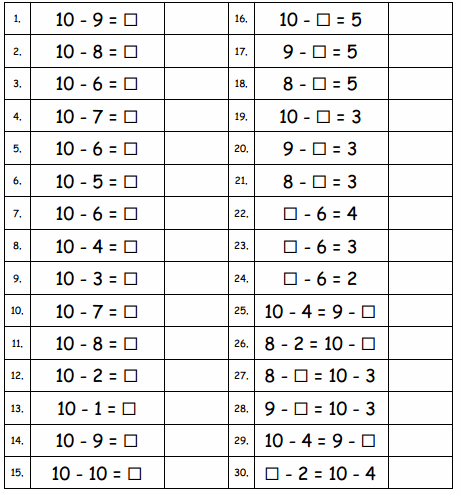
Answer:
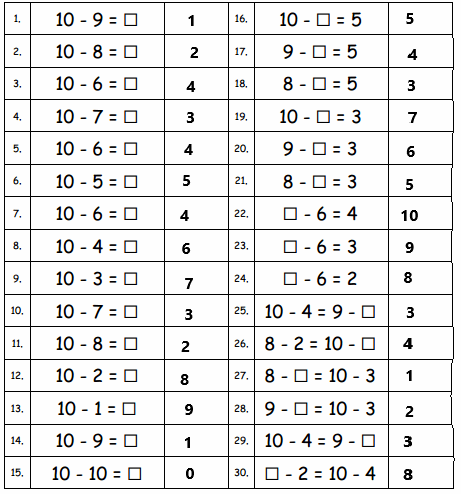
Question 1.
10 – 9 = ☐
Answer:
10 – 9 = 1
Explanation:
Subtraction is an arithmetic operation that represents the operation of removing objects from a collection. The result of a subtraction is called a difference. Subtract nine from ten then we got one.
Question 2.
10 – 8 = ☐
Answer:
10 – 8 = 2
Explanation:
Subtraction is an arithmetic operation that represents the operation of removing objects from a collection. The result of a subtraction is called a difference. Subtract eight from ten then we got two.
Question 3.
10 – 6 = ☐
Answer:
10 – 6 = 4
Explanation:
Subtraction is an arithmetic operation that represents the operation of removing objects from a collection. The result of a subtraction is called a difference. Subtract six from ten then we got four.
Question 4.
10 – 7 = ☐
Answer:
10 – 7 = 3
Explanation:
Subtraction is an arithmetic operation that represents the operation of removing objects from a collection. The result of a subtraction is called a difference. Subtract seven from ten then we got three.
Question 5.
10 – 6 = ☐
Answer:
10 – 6 = 4
Explanation:
Subtraction is an arithmetic operation that represents the operation of removing objects from a collection. The result of a subtraction is called a difference. Subtract six from ten then we got four.
Question 6.
10 – 5 = ☐
Answer:
10 – 5 = 5
Explanation:
Subtraction is an arithmetic operation that represents the operation of removing objects from a collection. The result of a subtraction is called a difference. Subtract five from ten then we got five.
Question 7.
10 – 6 = ☐
Answer:
10 – 6 = 4
Explanation:
Subtraction is an arithmetic operation that represents the operation of removing objects from a collection. The result of a subtraction is called a difference. Subtract six from ten then we got four.
Question 8.
10 – 4 = ☐
Answer:
10 – 4 = 6
Explanation:
Subtraction is an arithmetic operation that represents the operation of removing objects from a collection. The result of a subtraction is called a difference. Subtract four from ten then we got six.
Question 9.
10 – 3 = ☐
Answer:
10 – 3 = 7
Explanation:
Subtraction is an arithmetic operation that represents the operation of removing objects from a collection. The result of a subtraction is called a difference. Subtract three from ten then we got seven.
Question 10.
10 – 7 = ☐
Answer:
10 – 7 = 3
Explanation:
Subtraction is an arithmetic operation that represents the operation of removing objects from a collection. The result of a subtraction is called a difference. Subtract seven from ten then we got three.
Question 11.
10 – 8 = ☐
Answer:
10 – 8 = 2
Explanation:
Subtraction is an arithmetic operation that represents the operation of removing objects from a collection. The result of a subtraction is called a difference. Subtract eight from ten then we got two.
Question 12.
10 – 2 = ☐
Answer:
10 – 2 = 8
Explanation:
Subtraction is an arithmetic operation that represents the operation of removing objects from a collection. The result of a subtraction is called a difference. Subtract two from ten then we got eight.
Question 13.
10 – 1 = ☐
Answer:
10 – 1 = 9
Explanation:
Subtraction is an arithmetic operation that represents the operation of removing objects from a collection. The result of a subtraction is called a difference. Subtract one from ten then we got nine.
Question 14.
10 – 9 = ☐
Answer:
10 – 9 = 1
Explanation:
Subtraction is an arithmetic operation that represents the operation of removing objects from a collection. The result of a subtraction is called a difference. Subtract nine from ten then we got one.
Question 15.
10 – 10 = ☐
Answer:
10 – 10 = 0
Explanation:
Subtraction is an arithmetic operation that represents the operation of removing objects from a collection. The result of a subtraction is called a difference. Subtract ten from ten then we got zero.
Question 16.
10 – ☐ = 5
Answer:
10 – 5 = 5
Explanation:
Subtraction is an arithmetic operation that represents the operation of removing objects from a collection. The result of a subtraction is called a difference. Subtract five from ten then we got five.
Question 17.
9 – ☐ = 5
Answer:
9 – 4 = 5
Explanation:
Subtraction is an arithmetic operation that represents the operation of removing objects from a collection. The result of a subtraction is called a difference. Subtract four from nine then we got five.
Question 18.
8 – ☐ = 5
Answer:
8 – 3 = 5
Explanation:
Subtraction is an arithmetic operation that represents the operation of removing objects from a collection. The result of a subtraction is called a difference. Subtract three from eight then we got five.
Question 19.
10 – ☐ = 3
Answer:
10 – 7 = 3
Explanation:
Subtraction is an arithmetic operation that represents the operation of removing objects from a collection. The result of a subtraction is called a difference. Subtract seven from ten then we got three.
Question 20.
9 – ☐ = 3
Answer:
9 – 6 = 3
Explanation:
Subtraction is an arithmetic operation that represents the operation of removing objects from a collection. The result of a subtraction is called a difference. Subtract six from nine then we got three.
Question 21.
8 – ☐ = 3
Answer:
8 – 5 = 3
Explanation:
Subtraction is an arithmetic operation that represents the operation of removing objects from a collection. The result of a subtraction is called a difference. Subtract five from eight then we got three.
Question 22.
☐ – 6 = 4
Answer:
10 – 6 = 4
Explanation:
Subtraction is an arithmetic operation that represents the operation of removing objects from a collection. The result of a subtraction is called a difference. Subtract six from ten then we got four.
Question 23.
☐ – 6 = 3
Answer:
9 – 6 = 3
Explanation:
Subtraction is an arithmetic operation that represents the operation of removing objects from a collection. The result of a subtraction is called a difference. Subtract six from nine then we got three.
Question 24.
☐ – 6 = 2
Answer:
8 – 6 = 2
Explanation:
Subtraction is an arithmetic operation that represents the operation of removing objects from a collection. The result of a subtraction is called a difference. Subtract six from eight then we got two.
Question 25.
10 – 4 = 9 – ☐
Answer:
10 – 4 = 9 – 3
Explanation:
Subtraction is an arithmetic operation that represents the operation of removing objects from a collection. The result of a subtraction is called a difference. Subtract four from ten then we got six. Subtract three from nine then we got six. Both are equal number sentences.
Question 26.
8 – 2 = 10 – ☐
Answer:
8 – 2 = 10 – 4
Explanation:
Subtraction is an arithmetic operation that represents the operation of removing objects from a collection. The result of a subtraction is called a difference. Subtract two from eight then we got six. Subtract four from ten then we got six. Both are equal number sentences.
Question 27.
8 – ☐ = 10 – 3
Answer:
8 – 1 = 10 – 3
Explanation:
Subtraction is an arithmetic operation that represents the operation of removing objects from a collection. The result of a subtraction is called a difference. Subtract one from eight then we got seven. Subtract three from ten then we got seven. Both are equal number sentences.
Question 28.
9 – ☐ = 10 – 3
Answer:
9 – 2 = 10 – 3
Explanation:
Subtraction is an arithmetic operation that represents the operation of removing objects from a collection. The result of a subtraction is called a difference. Subtract two from nine then we got seven. Subtract three from ten then we got seven. Both are equal number sentences.
Question 29.
10 – 4 = 9 – ☐
Answer:
10 – 4 = 9 – 3
Explanation:
Subtraction is an arithmetic operation that represents the operation of removing objects from a collection. The result of a subtraction is called a difference. Subtract four from ten then we got six. Subtract three from nine then we got six. Both are equal number sentences.
Question 30.
☐ – 2 = 10 – 4
Answer:
8 – 2 = 10 – 4
Explanation:
Subtraction is an arithmetic operation that represents the operation of removing objects from a collection. The result of a subtraction is called a difference. Subtract two from eight then we got six. Subtract four from ten then we got six. Both are equal number sentences.
B
*Write the missing number.
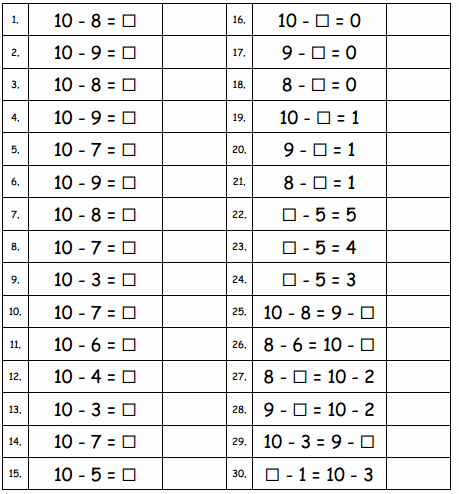
Answer:

Question 1.
10 – 8 = ☐
Answer:
10 – 8 = 2
Explanation:
Subtraction is an arithmetic operation that represents the operation of removing objects from a collection. The result of a subtraction is called a difference. Subtract eight from ten then we got two.
Question 2.
10 – 9 = ☐
Answer:
10 – 9 = 1
Explanation:
Subtraction is an arithmetic operation that represents the operation of removing objects from a collection. The result of a subtraction is called a difference. Subtract nine from ten then we got one.
Question 3.
10 – 8 = ☐
Answer:
10 – 8 = 2
Explanation:
Subtraction is an arithmetic operation that represents the operation of removing objects from a collection. The result of a subtraction is called a difference. Subtract eight from ten then we got two.
Question 4.
10 – 9 = ☐
Answer:
10 – 9 = 1
Explanation:
Subtraction is an arithmetic operation that represents the operation of removing objects from a collection. The result of a subtraction is called a difference. Subtract nine from ten then we got one.
Question 5.
10 – 7 = ☐
Answer:
10 – 7 = 3
Explanation:
Subtraction is an arithmetic operation that represents the operation of removing objects from a collection. The result of a subtraction is called a difference. Subtract seven from ten then we got three.
Question 6.
10 – 9 = ☐
Answer:
10 – 9 = 1
Explanation:
Subtraction is an arithmetic operation that represents the operation of removing objects from a collection. The result of a subtraction is called a difference. Subtract nine from ten then we got one.
Question 7.
10 – 8 = ☐
Answer:
10 – 8 = 2
Explanation:
Subtraction is an arithmetic operation that represents the operation of removing objects from a collection. The result of a subtraction is called a difference. Subtract eight from ten then we got two.
Question 8.
10 – 7 = ☐
Answer:
10 – 7 = 3
Explanation:
Subtraction is an arithmetic operation that represents the operation of removing objects from a collection. The result of a subtraction is called a difference. Subtract seven from ten then we got three.
Question 9.
10 – 3 = ☐
Answer:
10 – 3 = 7
Explanation:
Subtraction is an arithmetic operation that represents the operation of removing objects from a collection. The result of a subtraction is called a difference. Subtract three from ten then we got seven.
Question 10.
10 – 7 = ☐
Answer:
10 – 7 = 3
Explanation:
Subtraction is an arithmetic operation that represents the operation of removing objects from a collection. The result of a subtraction is called a difference. Subtract seven from ten then we got three.
Question 11.
10 – 6 = ☐
Answer:
10 – 6 = 4
Explanation:
Subtraction is an arithmetic operation that represents the operation of removing objects from a collection. The result of a subtraction is called a difference. Subtract six from ten then we got four.
Question 12.
10 – 4 = ☐
Answer:
10 – 4 = 6
Explanation:
Subtraction is an arithmetic operation that represents the operation of removing objects from a collection. The result of a subtraction is called a difference. Subtract four from ten then we got six.
Question 13.
10 – 3 = ☐
Answer:
10 – 3 = 7
Explanation:
Subtraction is an arithmetic operation that represents the operation of removing objects from a collection. The result of a subtraction is called a difference. Subtract three from ten then we got seven.
Question 14.
10 – 7 = ☐
Answer:
10 – 7 = 3
Explanation:
Subtraction is an arithmetic operation that represents the operation of removing objects from a collection. The result of a subtraction is called a difference. Subtract seven from ten then we got three.
Question 15.
10 – 5 = ☐
Answer:
10 – 5 = 5
Explanation:
Subtraction is an arithmetic operation that represents the operation of removing objects from a collection. The result of a subtraction is called a difference. Subtract five from ten then we got five.
Question 16.
10 – ☐ = 0
Answer:
10 – 10 = 0
Explanation:
Subtraction is an arithmetic operation that represents the operation of removing objects from a collection. The result of a subtraction is called a difference. Subtract ten from ten then we got zero.
Question 17.
9 – ☐ = 0
Answer:
9 – 9 = 0
Explanation:
Subtraction is an arithmetic operation that represents the operation of removing objects from a collection. The result of a subtraction is called a difference. Subtract nine from nine then we got zero.
Question 18.
8 – ☐ = 0
Answer:
8 – 8 = 0
Explanation:
Subtraction is an arithmetic operation that represents the operation of removing objects from a collection. The result of a subtraction is called a difference. Subtract eight from eight then we got zero.
Question 19.
10 – ☐ = 1
Answer:
10 – 9 = 1
Explanation:
Subtraction is an arithmetic operation that represents the operation of removing objects from a collection. The result of a subtraction is called a difference. Subtract nine from ten then we got one.
Question 20.
9 – ☐ = 1
Answer:
9 – 8 = 1
Explanation:
Subtraction is an arithmetic operation that represents the operation of removing objects from a collection. The result of a subtraction is called a difference. Subtract eight from nine then we got one.
Question 21.
8 – ☐ = 1
Answer:
8 – 7 = 1
Explanation:
Subtraction is an arithmetic operation that represents the operation of removing objects from a collection. The result of a subtraction is called a difference. Subtract seven from eight then we got one.
Question 22.
☐ – 5 = 5
Answer:
10 – 5 = 5
Explanation:
Subtraction is an arithmetic operation that represents the operation of removing objects from a collection. The result of a subtraction is called a difference. Subtract five from ten then we got five.
Question 23.
☐ – 5 = 4
Answer:
9 – 5 = 4
Explanation:
Subtraction is an arithmetic operation that represents the operation of removing objects from a collection. The result of a subtraction is called a difference. Subtract five from nine then we got four.
Question 24.
☐ – 5 = 3
Answer:
8 – 5 = 3
Explanation:
Subtraction is an arithmetic operation that represents the operation of removing objects from a collection. The result of a subtraction is called a difference. Subtract five from eight then we got three.
Question 25.
10 – 8 = 9 – ☐
Answer:
10 – 8 = 9 – 7
Explanation:
Subtraction is an arithmetic operation that represents the operation of removing objects from a collection. The result of a subtraction is called a difference. Subtract eight from ten then we got two. Subtract seven from nine then we got two. Both are equal number sentences.
Question 26.
8 – 6 = 10 – ☐
Answer:
8 – 6 = 10 -8
Explanation:
Subtraction is an arithmetic operation that represents the operation of removing objects from a collection. The result of a subtraction is called a difference. Subtract six from eight then we got two. Subtract eight from ten then we got two. Both are equal number sentences.
Question 27.
8 – ☐ = 10 – 2
Answer:
8 – 0 = 10 – 2
Explanation:
Subtraction is an arithmetic operation that represents the operation of removing objects from a collection. The result of a subtraction is called a difference. Subtract zero from eight then we got eight. Subtract two from ten then we got eight. Both are equal number sentences.
Question 28.
9 – ☐ = 10 – 2
Answer:
9 – 1 = 10 – 2
Explanation:
Subtraction is an arithmetic operation that represents the operation of removing objects from a collection. The result of a subtraction is called a difference. Subtract one from nine then we got eight. Subtract two from ten then we got eight. Both are equal number sentences.
Question 29.
10 – 3 = 9 – ☐
Answer:
10 – 3 = 9 – 2
Explanation:
Subtraction is an arithmetic operation that represents the operation of removing objects from a collection. The result of a subtraction is called a difference. Subtract three from ten then we got seven. Subtract two from nine then we got seven. Both are equal number sentences.
Question 30.
☐ – 1 = 10 – 3
Answer:
8 – 1 = 10 – 3
Explanation:
Subtraction is an arithmetic operation that represents the operation of removing objects from a collection. The result of a subtraction is called a difference. Subtract one from eight then we got seven. Subtract three from ten then we got seven. Both are equal number sentences.
Eureka Math Grade 1 Module 2 Lesson 14 Problem Set Answer Key
Question 1.
Match the pictures with the number sentences.

Answer:
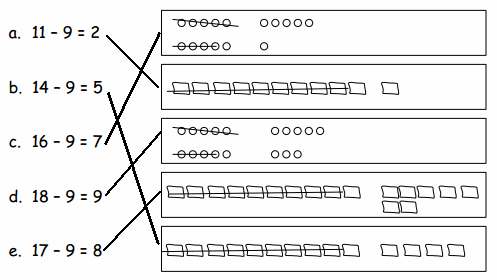
Explanation:
a. In the above image we can observe a number sentence 11 – 9 = 2. Break eleven into ten and one. Take nine from the ten. It’s called the take from ten strategy. Cross out nine squares. Then one and one make two. The number sentence matches with the second picture in the right side.
b. In the above image we can observe a number sentence 14 – 9 = 5. Break fourteen into ten and four. Take nine from the ten. It’s called the take from ten strategy. Cross out nine squares. Then one and four make five. The number sentence matches with the fifth picture in the right side.
c. In the above image we can observe a number sentence 16 – 9 = 7. Break sixteen into ten and six. Take nine from the ten. It’s called the take from ten strategy. Cross out nine circles. Then one and six make seven. The number sentence matches with the first picture in the right side.
d. In the above image we can observe a number sentence 18 – 9 = 9. Break eighteen into ten and eight. Take nine from the ten. It’s called the take from ten strategy. Cross out nine circles. Then one and eight make nine. The number sentence matches with the third picture in the right side.
e. In the above image we can observe a number sentence 17 – 9 = 8. Break seventeen into ten and seven. Take nine from the ten. It’s called the take from ten strategy. Cross out nine squares. Then one and seven make eight. The number sentence matches with the fourth picture in the right side.
![]() 10 and subtract.
10 and subtract.
Question 2.
12 – 9 = __
![]()
Answer:
12 – 9 = 3
![]()
Explanation:
In the above image we can observe a number sentence 12 – 9 = 3. Break twelve into ten and two. First draw a circle for ten candles then take nine candles from the ten candles. It’s called the take from ten strategy. Cross out nine candles. Then one candle and two candles make three candles.
Question 3.
14 – 9 = __
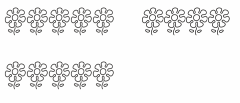
Answer:
14 – 9 = 5
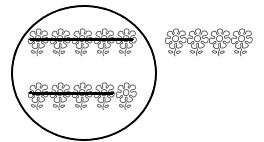
Explanation:
In the above image we can observe a number sentence 14 – 9 = 5. Break fourteen into ten and four. First draw a circle for ten flowers then take nine flowers from the ten flowers. It’s called the take from ten strategy. Cross out nine flowers. Then one flower and four flowers make five flowers.
Question 4.
15 – 9 =
![]()
Answer:
15 – 9 = 6
![]()
Explanation:
In the above image we can observe a number sentence 15 – 9 = 6. Break fifteen into ten and five. First draw a circle for ten apples then take nine apples from the ten apples. It’s called the take from ten strategy. Cross out nine apples. Then one apple and five apples make six apples.
Question 5.
13 – 9 = __

Answer:
13 – 9 = 4

Explanation:
In the above image we can observe a number sentence 13 – 9 = 4. Break thirteen into ten and three. First draw a circle for ten then take nine from the ten. It’s called the take from ten strategy. Cross out nine. Then one and three make four.
Question 6.
16 – 9 = __

Answer:
16 – 9 = 7
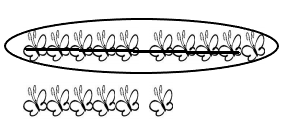
Explanation:
In the above image we can observe a number sentence 16 – 9 = 7. Break sixteen into ten and six. First draw a circle for ten butterflies then take nine butterflies from the ten butterflies. It’s called the take from ten strategy. Cross out nine butterflies. Then one butterfly and six butterflies make seven butterflies.
Question 7.
17 – 9 = __
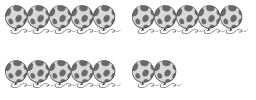
Answer:
17 – 9 = 8
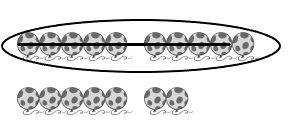
Explanation:
In the above image we can observe a number sentence 17 – 9 = 8. Break seventeen into ten and seven. First draw a circle for ten balloons then take nine balloons from the ten balloons. It’s called the take from ten strategy. Cross out nine balloons. Then one balloon and seven balloons make eight balloons.
Draw and ![]() 10. Then subtract.
10. Then subtract.
Question 8.
12 – 9 = ___
Answer:
12 – 9 = 3

Explanation:
Subtraction is an arithmetic operation that represents the operation of removing objects from a collection. In the above image we can observe a number sentence 12 – 9 = 3. Break twelve into ten and two. First draw a circle for ten then take nine from the ten. It’s called the take from ten strategy. Cross out nine. Then one and two make three.
Question 9.
13 – 9 = ___
Answer:
13 – 9 = 4
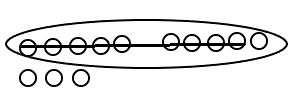
Explanation:
Subtraction is an arithmetic operation that represents the operation of removing objects from a collection. In the above image we can observe a number sentence 13 – 9 = 4. Break thirteen into ten and three. First draw a circle for ten then take nine from the ten. It’s called the take from ten strategy. Cross out nine. Then one and three make four.
Question 10.
14 – 9 = ___
Answer:
14 – 9 = 5
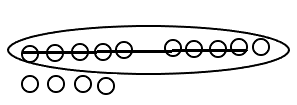
Explanation:
Subtraction is an arithmetic operation that represents the operation of removing objects from a collection. In the above image we can observe a number sentence 14 – 9 = 5. Break fourteen into ten and four. First draw a circle for ten then take nine from the ten. It’s called the take from ten strategy. Cross out nine. Then one and four make five.
Question 11.
15 – 9 = ___
Answer:
15 – 9 = 6

Explanation:
Subtraction is an arithmetic operation that represents the operation of removing objects from a collection. In the above image we can observe a number sentence 15 – 9 = 6. Break fifteen into ten and five. First draw a circle for ten then take nine from the ten. It’s called the take from ten strategy. Cross out nine. Then one and five make six.
Eureka Math Grade 1 Module 2 Lesson 14 Exit Ticket Answer Key
Draw and ![]() 10. Solve and make a number bond.
10. Solve and make a number bond.
Question 1.
17 – 9 = ____
Answer:
17 – 9 = 8

Explanation:
Subtraction is an arithmetic operation that represents the operation of removing objects from a collection. In the above image we can observe a number sentence 17 – 9 = 8. Break seventeen into ten and seven. First draw a circle for ten then take nine from the ten. It’s called the take from ten strategy. Cross out nine. Then one and seven make eight. The number bond seventeen is obtained with nine and eight.
Question 2.
14 – 9 = ____
Answer:
14 – 9 = 5

Explanation:
Subtraction is an arithmetic operation that represents the operation of removing objects from a collection. In the above image we can observe a number sentence 14 – 9 = 5. Break fourteen into ten and four. First draw a circle for ten then take nine from the ten. It’s called the take from ten strategy. Cross out nine. Then one and four make five. The number bond fourteen is obtained with nine and five.
Question 3.
15 – 9 = ___
Answer:
15 – 9 = 6

Explanation:
Subtraction is an arithmetic operation that represents the operation of removing objects from a collection. In the above image we can observe a number sentence 15 – 9 = 6. Break fifteen into ten and five. First draw a circle for ten then take nine from the ten. It’s called the take from ten strategy. Cross out nine. Then one and five make six. The number bond fourteen is obtained with nine and six.
Question 4.
18 – 9 = ___
Answer:
18 – 9 = 9

Explanation:
Subtraction is an arithmetic operation that represents the operation of removing objects from a collection. In the above image we can observe a number sentence 18 – 9 = 9. Break eighteen into ten and eight. First draw a circle for ten then take nine from the ten. It’s called the take from ten strategy. Cross out nine. Then one and eight make nine. The number bond eighteen is obtained with nine and nine.
Eureka Math Grade 1 Module 2 Lesson 14 Homework Answer Key
Circle 10 and subtract. Make a number bond.
Question 1.
15 – 9 = ___

Answer:
15 – 9 = 6

Explanation:
Subtraction is an arithmetic operation that represents the operation of removing objects from a collection. In the above image we can observe a number sentence 15 – 9 = 6. Break fifteen into ten and five. First draw a circle for ten then take nine from the ten. It’s called the take from ten strategy. Cross out nine. Then one and five make six. The number bond fifteen is obtained with nine and six.
Draw and ![]() 10. Subtract and make a number bond.
10. Subtract and make a number bond.
Question 2.
14 – 9 = ___
Answer:
14 – 9 = 5

Explanation:
Subtraction is an arithmetic operation that represents the operation of removing objects from a collection. In the above image we can observe a number sentence 14 – 9 = 5. Break fourteen into ten and four. First draw a circle for ten then take nine from the ten. It’s called the take from ten strategy. Cross out nine. Then one and four make five. The number bond fourteen is obtained with nine and five.
Question 3.
12 – 9 = ___
Answer:
12- 9 = 3

Explanation:
Subtraction is an arithmetic operation that represents the operation of removing objects from a collection. In the above image we can observe a number sentence 12 – 9 = 3. Break twelve into ten and two. First draw a circle for ten then take nine from the ten. It’s called the take from ten strategy. Cross out nine. Then one and two make three. The number bond twelve is obtained with nine and three.
Question 4.
13 – 9 = ___
Answer:
13 – 9 = 4

Explanation:
Subtraction is an arithmetic operation that represents the operation of removing objects from a collection. In the above image we can observe a number sentence 13 – 9 = 4. Break thirteen into ten and three. First draw a circle for ten then take nine from the ten. It’s called the take from ten strategy. Cross out nine. Then one and three make four. The number bond thirteen is obtained with nine and four.
Question 5.
16 – 9 = ___
Answer:
16 – 9 = 7

Explanation:
Subtraction is an arithmetic operation that represents the operation of removing objects from a collection. In the above image we can observe a number sentence 16 – 9 = 7. Break sixteen into ten and six. First draw a circle for ten then take nine from the ten. It’s called the take from ten strategy. Cross out nine. Then one and six make seven. The number bond sixteen is obtained with nine and seven.
Question 6.
Complete the number bond, and write the number sentence that helped you.
a.  ___
___
Answer:
 1 + 3 = 4
1 + 3 = 4
Explanation:
A number bond is a simple addition of two numbers that add up to give the sum. Break thirteen into ten and three. Take nine from the ten. It’s called the take from ten strategy. Then one and three make four. The number bond thirteen is obtained with nine and four. The number sentence is 1 + 3 = 4.
b.  ___
___
Answer:
 1 + 4 = 5
1 + 4 = 5
Explanation:
A number bond is a simple addition of two numbers that add up to give the sum. Break fourteen into ten and four. Take nine from the ten. It’s called the take from ten strategy. Then one and four make five. The number bond thirteen is obtained with nine and five. The number sentence is 1 + 4 = 5.
c.  __
__
Answer:
 1 + 5 = 6
1 + 5 = 6
Explanation:
A number bond is a simple addition of two numbers that add up to give the sum. Break fifteen into ten and five. Take nine from the ten. It’s called the take from ten strategy. Then one and five make six. The number bond fifteen is obtained with nine and six. The number sentence is 1 + 5 = 6.
d.  __
__
Answer:
 1 + 6 = 7
1 + 6 = 7
Explanation:
A number bond is a simple addition of two numbers that add up to give the sum. Break sixteen into ten and six. Take nine from the ten. It’s called the take from ten strategy. Then one and six make seven. The number bond sixteen is obtained with nine and seven. The number sentence 1 + 6 = 7.
Question 7.
Make the number bond that would come next, and write a number sentence that matches.
Answer:
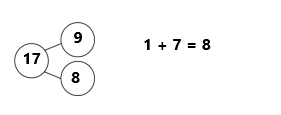
Explanation:
A number bond is a simple addition of two numbers that add up to give the sum. Break seventeen into ten and seven. Take nine from the ten. It’s called the take from ten strategy. Then one and seven make eight. The number bond seventeen is obtained with nine and eight. The number sentence is 1 + 7 = 8.